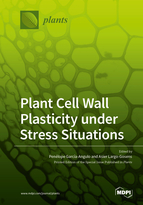Plant Cell Wall Plasticity under Stress Situations
A special issue of Plants (ISSN 2223-7747). This special issue belongs to the section "Plant Cell Biology".
Deadline for manuscript submissions: closed (31 January 2022) | Viewed by 21171
Special Issue Editors
Interests: plant biotechnology; cell culture; cell wall; plant biology; plant genetics; plant breeding; plant defense; plant physiology; polymers; biotechnology
Interests: plant biotechnology; genetics; gene regulation; molecular biology; PCR; cell wall; plant breeding; plant genetics; plant biology; plant physiology; biochemistry
Special Issue Information
Dear Colleagues,
The plant cell wall is a structure mainly made of complex polysaccharides with multiple interactions that conform to a network, which is extremely resistant. The acquisition of this structure allowed plants to colonize the land and acquire the typical erect plant appearance that allows them to grow taller to ensure the absorption of sunlight. Among other important functions, such as plant growth and defense, the transport of water and nutrients throughout the plant would not be possible without cell walls.
The cell wall is composed of cellulose, the most abundant and resistant polysaccharide on earth. This cellulose scaffold is involved in a matrix made of polysaccharides such as pectins and hemicelluloses, whose type and proportions vary depending on species, tissues and also cell types. The deposition of lignin—the second most abundant polymer on earth—into secondary cell walls increases the cell wall resistance, producing growth cessation. All these polymers are crosslinked into the wall in a process that can occur naturally and/or by the action of different modifying enzymes. The control of the synthesis of the cell wall components and/or the interactions among them gives this structure a high plasticity, which is a key factor in the modulation of the growth and defense responses under different stresses.
This Special Issue focuses on deepening the knowledge of the cell wall plasticity under different stress situations, paying attention to the main polymers and their interactions. Contributions from different points of view are welcome, including biochemistry, plant physiology, crop breeding, environmental adaptation, molecular biology, hormone effect, evolution and biotic and abiotic stresses.
Dr. Penélope García-Angulo
Dr. Asier Largo-Gosens
Guest Editors
Manuscript Submission Information
Manuscripts should be submitted online at www.mdpi.com by registering and logging in to this website. Once you are registered, click here to go to the submission form. Manuscripts can be submitted until the deadline. All submissions that pass pre-check are peer-reviewed. Accepted papers will be published continuously in the journal (as soon as accepted) and will be listed together on the special issue website. Research articles, review articles as well as short communications are invited. For planned papers, a title and short abstract (about 100 words) can be sent to the Editorial Office for announcement on this website.
Submitted manuscripts should not have been published previously, nor be under consideration for publication elsewhere (except conference proceedings papers). All manuscripts are thoroughly refereed through a single-blind peer-review process. A guide for authors and other relevant information for submission of manuscripts is available on the Instructions for Authors page. Plants is an international peer-reviewed open access semimonthly journal published by MDPI.
Please visit the Instructions for Authors page before submitting a manuscript. The Article Processing Charge (APC) for publication in this open access journal is 2700 CHF (Swiss Francs). Submitted papers should be well formatted and use good English. Authors may use MDPI's English editing service prior to publication or during author revisions.
Keywords
- Abiotic stress
- Biotic stress
- Cell wall enzymes
- Cell wall functions
- Cell wall plasticity
- Cell wall polymers
- Crosslinking








